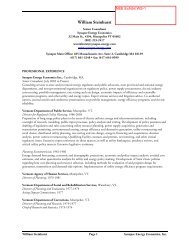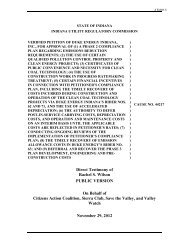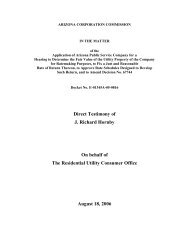Best Practices in Energy Efficiency Program Screening - Synapse ...
Best Practices in Energy Efficiency Program Screening - Synapse ...
Best Practices in Energy Efficiency Program Screening - Synapse ...
You also want an ePaper? Increase the reach of your titles
YUMPU automatically turns print PDFs into web optimized ePapers that Google loves.
<strong>in</strong>vest<strong>in</strong>g <strong>in</strong> society, and should be analyzed us<strong>in</strong>g a discount rate appropriate to society<br />
as a whole.<br />
The social discount rate should reflect the benefit to society as a whole, and should also<br />
take <strong>in</strong>to account both the reduced risk of energy efficiency <strong>in</strong>vestments, as well as<br />
society’s reduced time preference for a societal payback. This social discount rate is<br />
typically the lowest discount rate that reflects <strong>in</strong>creased value <strong>in</strong> future sav<strong>in</strong>gs. The<br />
Societal Cost test also <strong>in</strong>cludes environmental externality costs, which should arguably<br />
be discounted at a very low discount rate, if at all.<br />
Discount Rate for the PAC and TRC Tests<br />
The purpose of the TRC and PAC tests is to compare energy efficiency <strong>in</strong>vestments with<br />
the decision-maker’s other <strong>in</strong>vestment options. Historically, the discount<strong>in</strong>g challenge<br />
was relatively straightforward for these tests: the primary decision maker was the utility,<br />
and its WACC was used. (See, for example, NAPEE 2008, p.4-8.) This was seen as<br />
treat<strong>in</strong>g energy efficiency <strong>in</strong>vestments comparable to <strong>in</strong>vestments <strong>in</strong> supply-side<br />
resources, assum<strong>in</strong>g that consumers would be pay<strong>in</strong>g the same cost of capital on any<br />
utility <strong>in</strong>vestment.<br />
More recently, it has become clear that there are significant differences <strong>in</strong> the f<strong>in</strong>ancial<br />
risks associated with supply- and demand-side resource <strong>in</strong>vestments. <strong>Energy</strong> efficiency<br />
<strong>in</strong>vestments are typically funded by a system benefit charge or a balanc<strong>in</strong>g account <strong>in</strong><br />
utility rates. In either case, there is little risk to the utility associated with these<br />
<strong>in</strong>vestments because they are passed directly on to customers <strong>in</strong>dependent of utility<br />
operations, utility performance or other risk factors. Consequently, an energy efficiency<br />
<strong>in</strong>vestment is less risky than a supply-side <strong>in</strong>vestment on a purely f<strong>in</strong>ancial basis, <strong>in</strong><br />
addition to be<strong>in</strong>g less risky with regard to plann<strong>in</strong>g, construction and operation.<br />
Therefore, a lower discount rate than the WACC (i.e., a risk-adjusted discount rate)<br />
should be used <strong>in</strong> apply<strong>in</strong>g the PAC test or the TRC test.<br />
This lower risk also exists <strong>in</strong> those <strong>in</strong>stances where a third party adm<strong>in</strong>isters the energy<br />
efficiency programs (e.g., Delaware, Hawaii, Ma<strong>in</strong>e, New York, Oregon, Vermont). In<br />
these cases, the utility WACC would clearly not be an appropriate discount rate,<br />
because that rate does not represent the time value of money to the third-party<br />
adm<strong>in</strong>istrator. The discount rate for third-party adm<strong>in</strong>istrator programs should be low for<br />
the same reason that discount rates for utility-adm<strong>in</strong>istered programs funded by system<br />
benefits charges should be low: there is very little f<strong>in</strong>ancial risk associated with the<br />
fund<strong>in</strong>g source, s<strong>in</strong>ce there is no long-term f<strong>in</strong>anc<strong>in</strong>g <strong>in</strong>volved.<br />
One option for develop<strong>in</strong>g a lower, risk-adjusted discount rate is to remove some, or all,<br />
of the risk premium and time preference embedded <strong>in</strong> the utility’s WACC. This could be<br />
achieved by compar<strong>in</strong>g the utility’s f<strong>in</strong>ancial risk profile to that of other companies with<br />
lower risks or with other market <strong>in</strong>dicators of low-risk <strong>in</strong>vestment rates.<br />
Another option is to use a more generic, market <strong>in</strong>dicator of a low-risk <strong>in</strong>vestment. For<br />
example the <strong>in</strong>terest rates on US Treasury Bills are widely regarded as a good <strong>in</strong>dication<br />
of low-risk <strong>in</strong>vestments. We are aware of at least three states that use the <strong>in</strong>terest rates<br />
on US Treasury bills as a low-risk discount rate for assess<strong>in</strong>g the cost-effectiveness of<br />
energy efficiency programs (ODC 2012; MADPU 2010; <strong>Efficiency</strong> ME 2009).<br />
We recommend that states use the <strong>in</strong>terest rates on long-term (e.g., 10-year) US<br />
Treasury Bills as the discount rate for the PAC and the TRC tests. This <strong>in</strong>dicator is<br />
| 52 <strong>Best</strong> <strong>Practices</strong> <strong>in</strong> <strong>Energy</strong> <strong>Efficiency</strong> <strong>Program</strong> Screen<strong>in</strong>g | www.nhpci.org







